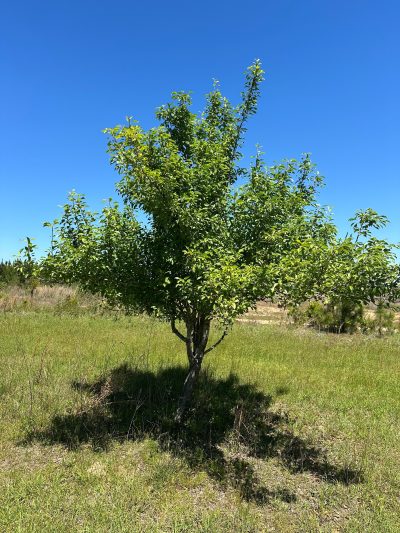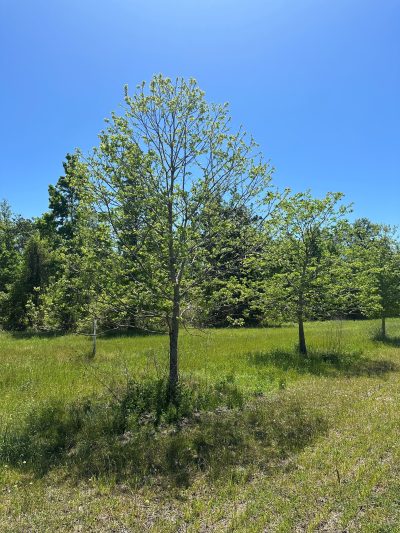
‘Baldwin’ Pear on the edge of a Calhoun County wildlife food plot. Photo courtesy of Daniel Leonard.
I haven’t yet met a hunter that didn’t want to improve his/her hunting situation and attract more deer. Over the last couple of years, I have written about several strategies Panhandle hunters can adopt to accomplish just that – namely planting warm season forages and adding hard mast producing trees. Though those two additions are great practices to adopt, there is another way to increase the wildlife attraction capabilities of your food plots – planting soft mast trees.
Unlike hard mast trees, which produce “hard” seeds or nuts (acorns, chestnuts, chinquapins, etc), soft mast trees yield what most of us would think of as “fruit” or “berries” (pears, apples, plums, etc.). Hard mast options typically ripen in late fall and may persist throughout the winter, providing a dense source of lasting protein and fat, along with a few carbohydrates. These attributes make hard mast important for sustaining animals through the winter when browsing options are scarce. Soft mast species, in contrast, drop ripened fruit containing large amounts of carbohydrates much earlier (late summer/early fall, often coinciding with archery season in the Panhandle) and help animals gain fat in anticipation of winter and, in the case of deer, their breeding season.
With those animal attracting attributes in mind, the next question becomes which soft mast species should you add to your Panhandle property? Fortunately, the property you hunt probably already possesses several native soft mast options that go unnoticed and underappreciated. These inconspicuous species include plants that provide valuable nutrition to wildlife like Chickasaw Plum, native blackberry, dewberry, wild muscadine grape, black cherry, American beautyberry, and others. Beyond these native options though, there are two soft mast species every hunter should consider, Pear (Pyrus spp.) and Persimmon (both the native Diospyros virginiana and non-native D. kaki).
Pears are extremely easy to grow in the Panhandle, being adapted to a variety of soil conditions, tolerant of our weather conditions once established, and bothered by few pests. There are many varieties of Pear available commercially, but area hunters should choose only low chill varieties (‘Baldwin’, ‘Flordahome’, ‘Hood’, ‘Keiffer’, ‘Pineapple’, etc.). Of those varieties listed, only ‘Baldwin’ requires a second pollinator tree, however its generally a good practice to plant multiple trees for best results.

Common Persimmon (Diospyros virginiana) growing on the edge of a wildlife food plot in Calhoun County. Photo courtesy of Daniel Leonard.
Persimmons are also simple to source in nurseries and are low-maintenance growers. The native Common Persimmon, Diospyros virginiana, is a medium-sized tree (40-50’ in height, usually smaller) found in abundance in sandy natural areas across the Panhandle. This species bears small, golf ball-sized fruit and are readily browsed by wildlife. If your property contains upland, sandy areas, there is a good chance you already have a thriving population of Common Persimmon and may not realize much benefit from adding additional trees. If you’re interested in planting Common Persimmon, make sure to source both male and female trees to ensure pollination and fruit. Even if you already have some Common Persimmon, most properties and food plots can benefit from the addition of a Japanese Persimmon (Diospyros kaki). These trees are smaller in stature (20-30’) than their American cousins but bear much sweeter, larger fruit (baseball sized or larger) and are highly prized by wildlife. The cultivar ‘Fuyu’ is the most common in the trade and, except for flooded areas, is highly adaptable to soil conditions and recommended for food plot plantings.
For best results when getting started growing both Pear and Persimmon, healthy potted or bareroot trees should be selected and planted in the dormant season (December through February in the Panhandle). Dig the planting hole slightly shallower than where the tree was in the container (or where the topmost root is on a bareroot specimen), tease apart the rootball, taking care to sever any circling or J roots, backfill with native soil (not compost or potting soil), and create a berm around the planting hole to hold water. Wire cages or similar exclusion method will be required to protect young trees from deer damage (both browsing foliage and rubbing antlers on stems). After your newly planted trees green up in the spring, they’ll appreciate some fertilizer; once mature, established trees require little to no fertilizer.
If you’re already managing your property well for wildlife, planting summertime food plots, burning to promote species diversity, and planting selected groves of hard mast trees, adding soft mast trees can be the “final frontier” in wildlife attraction. These species, like Pear and Persimmon, make excellent additions to wildlife food plots and provide a sweet treat in late summer/early fall, right when many other forage options are fading. Plan to add a few of these trees to your property next winter and enjoy hunting over them for years to come! For more information on enhancing wildlife habitat or any other agricultural related topics, contact your local UF/IFAS County Extension Office!
- Panhandle Cotton Acres Are Down in 2025– Here’s the Reason - July 11, 2025
- It Snowed, But Has This Been a Historically Cold Winter? What the Data Says. - January 31, 2025
- 2025 Fish Camp Webinar Series– February 10,17, & 24 - January 31, 2025
